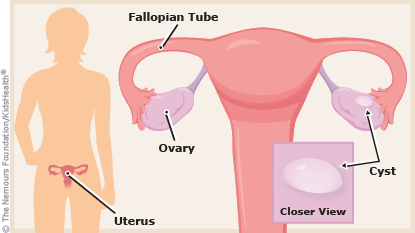What to know about ovarian cysts
They said the disorders account for 30% of women’s infertility, adding however that approximately…

ovarian cysts
Ovulatory disorders are one of the most common reasons why women are unable to conceive, according to experts.
They said the disorders account for 30% of women’s infertility, adding however that approximately 70% of these cases could be successfully treated.
According to a gynaecologist, Dr Baba Bihari, ovarian cysts are common particularly in women who are pregnant or who haven’t gone through menopause yet.
Bihari said ovarian cysts are fluid-filled sacs or pockets in an ovary or on its surface.
“Women have two ovaries on each side of the uterus. Many women have ovarian cysts at some point.
“And most of the time, they’re painless and harmless. A cyst becomes a problem when it doesn’t go away or it gets bigger,” he said.
The gynaecologist said there are two types of ovarian cysts. They are the corpus luteum and the follicle cysts.
He said corpus luteum makes hormones to prepare for the next egg for the next menstrual cycle, adding that corpus luteum cysts form if the sac doesn’t shrink.
He said instead, the sac reseals itself after the egg is released and then fluid builds up inside.
Most corpus luteum cysts go away after a few weeks but they can grow to almost four inches wide.
Explaining follicle cysts, he said during women’s menstrual cycle, an egg grows in a sac called follicle. This sac is located inside the ovaries and in most cases, this follicle or sac breaks open and releases an egg but if the follicle doesn’t break open, the fluid inside the follicle can form a cyst on the ovary.
The expert said a woman may not even know she has a cyst, but larger cysts may cause symptoms such as:
– Pelvic pain or a dull ache in your back
-Painful periods
-Pain during intercourse
-Breast tenderness
-Unusual vaginal bleeding and lastly
– Unexplained weight gain
Bihari said cysts on an ovary could be found during a pelvic exam depending on its size.
He said sometimes doctors recommend tests to determine the type and whether you need treatment.
He said possible tests include:
-Laparoscopy: This is when a doctor inserts a slim instrument with a light and a camera into your abdomen through a small cut and sees the ovaries and removes any ovarian cyst.
-Pelvic ultrasound: This uses sound waves to make an image of your uterus and ovaries. A doctor can confirm that you have a cyst, its location and pinpoint.
-Pregnancy test: A positive pregnancy test may mean you have a corpus luteum cyst.
Dr Baba said, ovarian cysts in women could be prevented through the following ways:
-Lifestyle changes
-A healthy weight
-Rule out fertility medication
-Schedule a gynaecologist appointment
-Steer clear of smoking cigarettes.
The gynaecologist said that most cysts go away on their own, and doctors suggest you should watch and wait for changes and also some doctors give medicine for pain.
They might also prescribe birth control pills. He said the hormones in the pills won’t make the cysts disappear but it can help to prevent new ones.
He said some ovarian cysts need surgery because cysts are more likely to be cancerous, adding that depending on the case, the surgeon may take just the cyst or the entire ovary.
The two types of surgery are:
– Laparotomy: This surgery is for cysts that may be cancerous and it is done with a bigger cut in the belly.
– Laparoscopy: This surgery is for smaller cysts. Doctors make a tiny cut above or below the belly button.
A small tool with a camera allows the doctor to see inside and a different tool removes the cyst or ovary. You probably won’t have to stay in the hospital.
“However, it is good for women to have ovarian cyst specialists because a specialist will recommend a treatment to shrink or remove the cyst if it doesn’t go away on its own or if it grows longer,” Dr Bihari advised.
